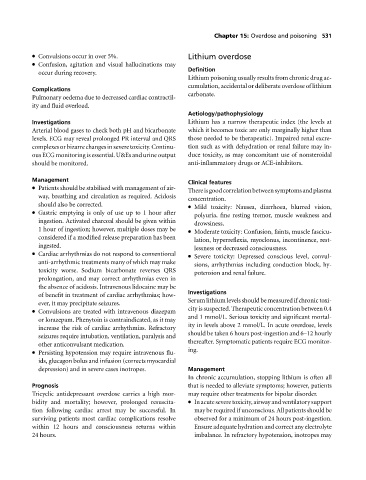Page 535 - Medicine and Surgery
P. 535
P1: KOA
BLUK007-15 BLUK007-Kendall May 12, 2005 20:54 Char Count= 0
Chapter 15: Overdose and poisoning 531
Convulsions occur in over 5%. Lithium overdose
Confusion, agitation and visual hallucinations may
Definition
occur during recovery.
Lithium poisoning usually results from chronic drug ac-
cumulation, accidental or deliberate overdose of lithium
Complications
carbonate.
Pulmonary oedema due to decreased cardiac contractil-
ity and fluid overload.
Aetiology/pathophysiology
Investigations Lithium has a narrow therapeutic index (the levels at
Arterial blood gases to check both pH and bicarbonate which it becomes toxic are only marginally higher than
levels. ECG may reveal prolonged PR interval and QRS those needed to be therapeutic). Impaired renal excre-
complexesorbizarrechangesinseveretoxicity.Continu- tion such as with dehydration or renal failure may in-
ous ECG monitoring is essential. U&Es and urine output duce toxicity, as may concomitant use of nonsteroidal
should be monitored. anti-inflammatory drugs or ACE-inhibitors.
Management
Clinical features
Patients should be stabilised with management of air- Thereisgoodcorrelationbetweensymptomsandplasma
way, breathing and circulation as required. Acidosis concentration.
should also be corrected. Mild toxicity: Nausea, diarrhoea, blurred vision,
Gastric emptying is only of use up to 1 hour after polyuria, fine resting tremor, muscle weakness and
ingestion. Activated charcoal should be given within drowsiness.
1 hour of ingestion; however, multiple doses may be Moderate toxicity: Confusion, faints, muscle fascicu-
considered if a modified release preparation has been lation, hyperreflexia, myoclonus, incontinence, rest-
ingested. lessness or decreased consciousness.
Cardiac arrhythmias do not respond to conventional Severe toxicity: Depressed conscious level, convul-
anti-arrhythmic treatments many of which may make
sions, arrhythmias including conduction block, hy-
toxicity worse. Sodium bicarbonate reverses QRS
potension and renal failure.
prolongation, and may correct arrhythmias even in
the absence of acidosis. Intravenous lidocaine may be
Investigations
of benefit in treatment of cardiac arrhythmias; how-
Serum lithium levels should be measured if chronic toxi-
ever, it may precipitate seizures.
city is suspected. Therapeutic concentration between 0.4
Convulsions are treated with intravenous diazepam
and 1 mmol/L. Serious toxicity and significant mortal-
or lorazepam. Phenytoin is contraindicated, as it may
ity in levels above 2 mmol/L. In acute overdose, levels
increase the risk of cardiac arrhythmias. Refractory
should be taken 6 hours post-ingestion and 6–12 hourly
seizures require intubation, ventilation, paralysis and
thereafter. Symptomatic patients require ECG monitor-
other anticonvulsant medication.
ing.
Persisting hypotension may require intravenous flu-
ids, glucagon bolus and infusion (corrects myocardial
depression) and in severe cases inotropes. Management
In chronic accumulation, stopping lithium is often all
Prognosis that is needed to alleviate symptoms; however, patients
Tricyclic antidepressant overdose carries a high mor- may require other treatments for bipolar disorder.
bidity and mortality; however, prolonged resuscita- Inacuteseveretoxicity,airwayandventilatorysupport
tion following cardiac arrest may be successful. In may be required if unconscious. All patients should be
surviving patients most cardiac complications resolve observed for a minimum of 24 hours post-ingestion.
within 12 hours and consciousness returns within Ensure adequate hydration and correct any electrolyte
24 hours. imbalance. In refractory hypotension, inotropes may

